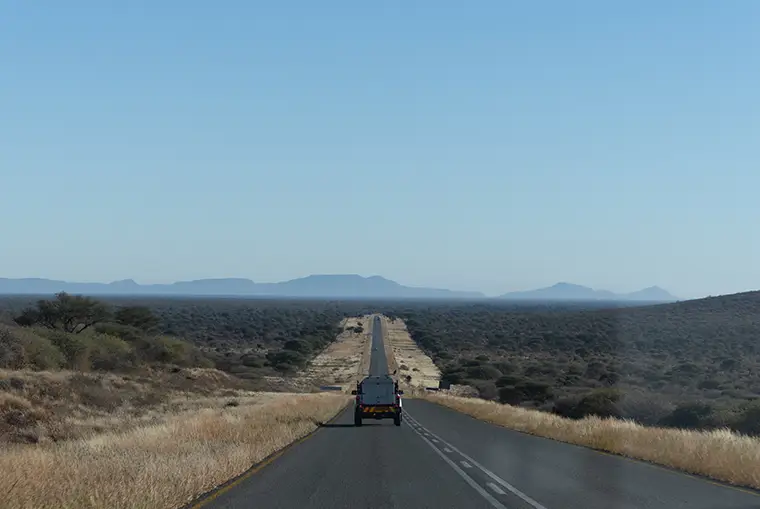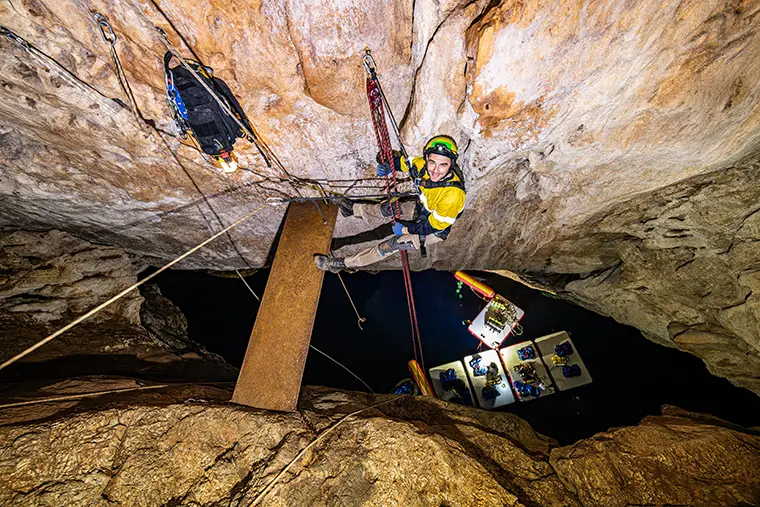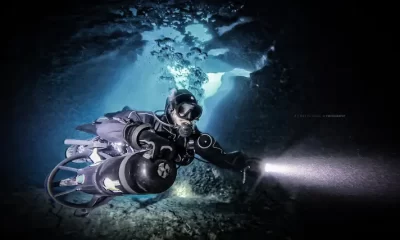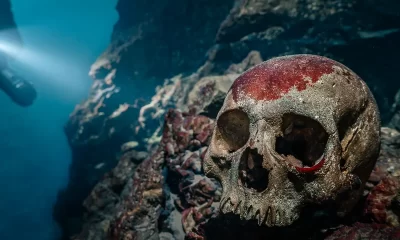

Exploration
Deep in Dragon’s Breath
Dr. Bill Stone’s robot Sunfish mapped Dragon’s Breath Cave, in Namibia, which is the home to the deepest subterranean lake on the planet. But the humans still wanted their shot. Leave it to German cave explorer Oliver Schöll and his team who pushed 100m depths last summer in the hopes of scooping booty. Here is their story.
By Oliver Schöll. Photos courtesy of the author. Lead image: The team descending into the mouth of the Dragon!
Our six-day expedition to Dragon’s Breath Cave in Namibia (home to the largest underground lake in the world) was both an unforgettable adventure and a fascinating challenge that pushed us—in a good way—to our physical and mental limits. Participants in the expedition were; Tom Baier, Alan Calovs, Louw Greef, Stefan Gries, Stefan Pape, Oliver Schöll, Markus Schuster, Chris Steencamp, and Ralf Wupper.
Preparations
A year before the expedition, our team began meeting regularly to train the specialized skills we would need. Our goal lay about 60 m/200 ft below the surface, and every move had to be perfect. A mistake on-site could have fatal consequences—an injury, such as a twisted ankle or a broken limb would be a serious issue, not to mention the risks of a diving accident.
During an exploration in 2023, we had discovered there was no land to stand on ahead of the dive, forcing us to set up our base on floating pontoons. The plan was to assemble our rebreathers on the pontoons where we would prepare for the dive. The next day, we would lower ourselves into a boat, change into our drysuits there, and swim to the equipment to finalize our preparations. The biggest challenge: we were eight people!
In pool training, we had practiced lowering ourselves into inflatable boats from a three-meter platform and donning drysuits and rebreathers in the water. After several trial runs, we cut the time per person from 20 minutes to around 7 to 10 minutes. This allowed us to reduce the total time for all eight divers to about an hour. We also met multiple times in southern Germany to practice Single Rope Technique (SRT) in caves.

Day 1 – Friday, June 14, 2024: Arrival and Preparation
On June 12, 2024, the time had finally come: our flight to Namibia. With over 800 kg/1,764 lbs of equipment, we embarked on our journey to Dragon’s Breath Cave. Our clear goal: a team of six divers aimed to reach a depth of 200 meters—deeper than anyone before in the system.
After arriving in Windhoek, we drove about 450 km/280 mi to Haarsieb Farm near Tsumeb. The Otavi region, where the farm is located, stretches east of Etosha National Park and forms the so-called Otavi Triangle with the towns of Otavi, Tsumeb, and Grootfontein. The farm is nestled in the vegetation- and wildlife-rich Otavi Highlands.
The farm owners welcomed us warmly, and we immediately began preparations. Nothing was left to chance. Tom had special bags made in Namibia for the AL 80 stage cylinders—we had a total of 24. Each of us had a specific color for our gear to maintain clear organization (mine was black). This way, everyone knew what belonged to whom.

The farm offered us a small guest area where we set up camp. The excitement and nerves were palpable as we checked our equipment one last time. Over the coming days, we would descend deep underground, and it was crucial that everything was perfectly prepared.
At 9 pm, we went to bed early. I spent the evening preparing my camera equipment. Every detail had to be right, as I was responsible for documenting the entire expedition photographically. From this point forward, it was all about focus.

Day 2 – Saturday, June 15, 2024: The Descent Begins
At 5:30 am, I was awakened by the cold—it was only 5 °C/41 °F, typical for the African winter. After freshening up, I reviewed my gear and thought about the upcoming conditions in the cave. At 6 am, the farm owner greeted us with a hearty breakfast, including marinated game, eggs, and bacon.
At sunrise, we set off for the cave entrance. After a short drive, the hard work began: we had to transport all our gear—about 1.5 tons—over a 200-meter distance to the cave entrance. After an hour, everything was in front of the seemingly modest opening of Dragon’s Breath Cave. In the middle of the bushland, about 1,550 meters/5,085 ft above sea level, lay the entrance to the massive underground lake.
The descent began with a five-m/16-ft rope ladder. Tom and I manned the ground station. Working our way down several shafts, we reached a bridge—more of a narrow, rusty, steel plate wedged in a rock crevice. From there, we could gaze at the dark blue, seemingly impenetrable surface of the water. Louw Greef positioned himself on the bridge, ensuring the safe transport of equipment down to the water.





As I harnessed into the rope and lowered myself toward the lake, I suddenly noticed that my light wasn’t working. No matter how often I checked the settings on my Scurion lamp, everything remained black. Then I realized: the lake was so vast that it swallowed the light.
Thanks to the groundwork done by Chris Steenkamp, who had prepped the cave two weeks earlier, we managed to transport the gear down without any issues. The darkness and narrow spaces of the cave were overwhelming, but the team worked flawlessly together. Every move was precise. On the first day, we managed to bring most of the equipment into the cave.
Day 3 – Sunday, June 16, 2024: Final Preparations for the Dive
The work was grueling! Each of us had a station, helping to move the heavy rebreathers and the rest of the diving gear down the shaft. With 100% humidity and a temperature of 30 °C/86 °F, it was an exhausting task. Yet, the breathtaking view of the crystal-clear water made up for the effort.
Each diver assembled their JJ-CCR rebreather on the platform and conducted functionality tests. After a short break, we continued with the final preparations for the dive. The plan was clear: Tom Baier, Stefan Gries, Markus Schuster, Alan Calvos, and Ralf Wupper would descend to 200 m/656 ft. Chris and I would dive to 100 m/328 ft to capture photos of the team’s descent.

Day 4 – Monday, June 17, 2024: The Dive
Day four was the highlight of our expedition. After an early breakfast, we arrived at the cave entrance at sunrise. Everything was prepared, everyone was focused, and all of us were in peak condition. One by one, we descended to the water’s surface as planned, put our drysuits on, and got dive-ready. The water temperature was a comfortable 25 °C/77 °F, but with dive durations of up to 10 hours, even in a drysuit, we would eventually feel the cold.
We began our descent. The silence was overwhelming, and the space beneath us seemed infinite. In the clear water, the walls vanished into nothingness. Tom secured the reel to a rocky spike, and the deco stages hung from a 50-m/160-ft line—perfect for emergencies. Slowly, we sank deeper into the abyss. Only our compasses provided direction. At 60 m/200 ft, we reached the floor and secured the reel again.


The divers’ video lights, with 50,000 lumens each, illuminated the cave like daylight. Ahead, the main passage opened up, sloping at an angle of 30 to 40 degrees into the depths. It was as if we were floating in outer space. This passage was the largest I had ever seen as a cave diver: bottomless, with no visible ceiling or walls, even with 100 m/328 ft of visibility.
I took photos and observed the team. At 100 m, the groups separated. Chris and I remained to capture the final shots before making our way to the shotline, where the bailout stages were suspended. We began the roughly four-hour decompression. Forty-five minutes later, the rest of the team followed.
After the decompression, we spent the night on the pontoons inside the cave, feeling good after a strenuous but successful dive.
Day 5 – Tuesday, June 18, 2024: Breakdown and Transport
The next day, following the successful dive, we began transporting the equipment back up.. Thanks to our well-coordinated teamwork, everything went smoothly and, by 6 pm, all of the gear had been removed from the cave. The relief and joy over our achievement were immense, and we celebrated late into the night.

Day 6: Conclusion and Reflection
On the final day, we packed up camp and reflected on the past days. Each of us felt a sense of pride in what we had accomplished, coupled with a deep humility in the face of the challenges we had risen to.
The memories of the struggles, the narrow passages, the seemingly endless descent, and the overwhelming beauty of the cave will stay with us for a lifetime. We had not only explored the darkness and depths of the Dragon’s Breath Cave but also proven our trust in our abilities and the strength of the team.
This expedition was a triumphant testament to the cohesion, endurance, and determination of the entire team. Each of us returned with a sense of fulfillment and a profound respect for the untouched, mysterious world beneath the earth. The Dragon’s Breath Cave revealed some of its secrets to us, but its full depth and size remain an enigma, beckoning future explorers.
DIVE DEEPER
Discover: This AI-Guided Drone Has Mapped One of Earth’s Deepest Subterranean Lakes By Alex Orlando A team of roboticists and divers used an AI-powered drone to explore underwater caves farther than humans ever have.
Stone Aerospace: Dragon’s Breath Cave
Stone Aerospace:3D Visualizations (Dragon’s Breath Cave)
Austin American-Statesmen: Austin’s Stone Aerospace shoots for the stars by Hojun Choi

Oliver Schöll, born in 1970, started diving in 1990 and discovered his passion for caves. In 1996, he completed his Full Cave Diver with Gunnar Wager in Tulum, Mexico. He is a member of ARGE Blautopf and the Cavebase Team. His biggest joy is going where no one has been before and bringing back pictures and videos. He has been involved in many expeditions all over the world and is lucky enough to always discover new land!
Homepage: www.oliver-schoell.de
Facebook: https://www.facebook.com/oliver.scholl.148
Instagram: https://www.instagram.com/oliver.schoell/


















































